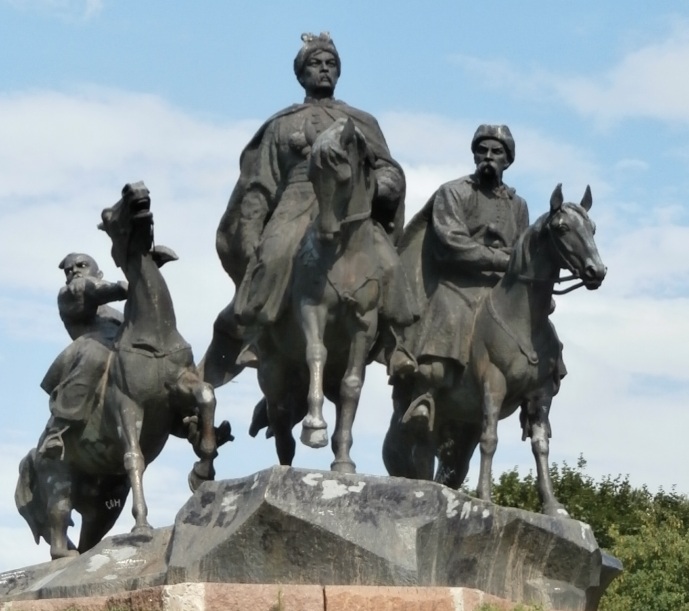Putin’s propaganda points to a soft spot
Russian President Vladimir Putin and his media machine vilify the new Ukrainian government as fascists, Nazis and anti-Semites. That, of course, is propaganda to justify Russia’s intervention and annexation of Crimea. Yet the Kremlin’s propaganda does have an effect – because it contains a kernel of truth.
The Svoboda Party represented in the new government really is a far-right faction. The “Pravyi Sektor” (Right Sector) is even more radical. This militant group played a key part in the clashes in Kiev against the forces of ousted President Viktor Yanukovych. A remark by one of Svoboda’s politicians, Ihor Miroshnychenko, can be considered typical. “She’s no real Ukrainian, because she’s a dirty Jew,” he said about the Hollywood actress Mila Kunis, who grew up in Ukraine.
Jews as scapegoats
Svoboda and Pravyi Sektor do not discredit the entire Ukrainian liberation movement, but anti-Semitism has remained a constant throughout Ukraine’s history. In the search for their own national heroes and narrative independent of Poland and Russia, people in Ukraine have had few qualms about glorifying individuals who hated and even killed Jews. Notable examples are Bohdan Khmelnytsky and Stepan Bandera.
Today, Bohdan Khmelnytsky is revered in Ukraine as the founder of the Ukrainian state and liberator from Polish rule. Under his leadership, a Cossack army began a successful campaign in 1648 against the army of the Polish Crown. Because Russia did not fulfill requests for aid, the Cossacks allied themselves with the Crimean Tatars. During Khmelnytsky’s march westward, massacres were carried out against Poles, Jesuits, Catholic clergy and Jews. Thousands of Jews were killed because of their economic ties to the Polish nobility. They were a welcome scapegoat. In his World History of the Jewish People, the renowned Russian-Jewish historian Simon Dubnow (1861-1940) places the Cossacks among the ranks of the Jewish people’s worst enemies.
Insurgencies and collaboration
Ukraine’s precarious location between Poland and Russia and anti-Semitic tendencies also marked the life of Stepan Bandera (1909-1959), who in Ukraine’s western regions is revered as a freedom fighter, but despised as a Nazi collaborator in the country’s east. As a member of the Organization of Ukrainian Nationalists (OUN) from 1928, Bandera campaigned for Ukrainian independence, which then was under Soviet rule and partially occupied by Poland.
Bandera’s OUN cooperated with the Nazis. On June 30, 1941, even before the arrival of the regular German army, the OUN is believed to have massacred some 7000 people, most of them Communists and Jews, in the city of Lviv. Shortly thereafter, Bandera proclaimed an independent Ukrainian state – something that displeased the Nazis. Bandera realized that the Germans regarded not only Poles and Russians, but also Ukrainians – who at first enthusiastically welcomed the German invasion – as “subhuman” Slavs. In July 1941 Bandera was taken to the Sachsenhausen Concentration Camp.
After being released in September 1944, he initially fought as a leader of the Ukrainian Insurgent Army (UPA) with Soviet partisans against the Germans, and then again against the Red Army for Ukrainian independence. In an act of retribution, Bandera, who had fled after the war through Austria to West Germany, was killed by KGB agents on October 15, 1959.
Babi Yar
The Babi Yar massacre took place shortly after the Wehrmacht had marched into Kiev. Following attacks on German troops, the Wehrmacht and SS decided to retaliate by killing as many of Kiev’s Jews as possible. The planning was disguised as an “evacuation operation of the Jews.” The Germans, who later would underscore the “seamless cooperation” of all parties involved, planned the massacre with military precision. On September 28, 1941, wall posters in Russian, Ukrainian and German were put up instructing the Jews of Kiev to assemble the following day near the train station and bring along money, valuables, warm clothing, and ID. “Anyone who does not obey this summons and is encountered elsewhere will be shot. Anyone entering the deserted apartments of Jews or removing possessions will be shot,” it read.
Few Jews refused to go to the assembly area or tried to escape. The Nazis herded them out of the city to the nearby Babi Yar ravine. There they were told to undress and afterward were systematically shot using automatic weapons. Within 36 hours, 33,771 Jews had died. Another 17,000 Kiev Jews were killed by October 12. The belongings of those killed were distributed among ethnic Germans and needy Kiev residents.
In his 2005 book Täter (Perpetrators), sociologist Harald Welzer used transcripts of subsequent interviews and interrogations to demonstrate that, until the end of their lives, most of the gunmen felt no moral qualms regarding their deeds.
Coming to grips with the past
The same goes for John (formerly Ivan) Demjanjuk (1920-2012), whose trial three years ago received significant media attention. Ukraine-born Demjanjuk served first in the Red Army, was taken prisoner and became an SS auxiliary in 1942. Because of war crimes he committed as an SS guard Demjanjuk, who immigrated to the US after the war, was deported first to Israel and then to Germany. On May 12, 2011 he was convicted in Munich of being an accessory in the murders of thousands of prisoners in the Sobibor extermination camp, and sentenced to five years in prison. Demjanjuk could not be held directly accountable for any particular killing, but the court regarded his service in Sobibor in 1943 as sufficient for a conviction, as there Demjanjuk became “part of the machinery of extermination.” Because both the defense and prosecution appealed, Demjanjuk’s conviction never took effect before he died.
Ukrainians are not collectively guilty, but most of the country’s people have never come to grips with their anti-Semitic past. Looking to the future, their principle should be that anti-Semites have no place in a democratic government.
Dieter Sattler is the head of the politics section of the daily Frankfurter Neue Presse
